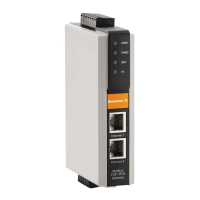
Do you have a question about the Weidmüller IE-GW-MB-2TX-1RS232/485 and is the answer not in the manual?
| Brand | Weidmüller |
|---|---|
| Model | IE-GW-MB-2TX-1RS232/485 |
| Category | Gateway |
| Language | English |
Overview of the Modbus TCP/RTU Gateway's features and capabilities.
Fundamental concepts of the Modbus protocol, including masters, slaves, and communication methods.
Description of the physical layout of the gateway's front and rear panels.
Explains the function and meaning of each LED indicator on the gateway.
Provides the physical dimensions and mounting specifications of the gateway.
Details the function of the internal DIP switches (jumpers) for configuration.
Instructions for mounting the gateway using DIN-rail or wall mounting methods.
Pin assignment details for serial ports (RS232, RS422/485) and power/relay connections.
Procedure for resetting the gateway to its factory default settings using the reset button.
Instructions on how to connect the gateway to a power source.
Guide on connecting serial devices using the DB9 connector or terminal block.
Steps for connecting the gateway to a host or network via Ethernet ports.
Guide to configuring the gateway using its integrated web interface.
Using the Modbus Gateway Administrator software for configuration and monitoring.
Configuration options for basic settings like mode, network, serial, and slave ID.
Accessing advanced configuration options for Modbus, priority control, and more.
Accessing maintenance functions like firmware upgrade and configuration management.
Rebooting the gateway device to apply changes or restart services.
Instructions for installing and launching the Modbus Gateway Administrator software.
Methods for finding and identifying Modbus Gateway devices on the network.
Steps to modify device configuration parameters using the administrator tool.
Using the "Locate" function to identify and verify specific gateway units.
Resetting the gateway to factory default values via the administrator tool.
Saving and loading gateway configurations using the administrator tool.
Updating the gateway's firmware using the administrator tool.
Creating or modifying configuration files without a connected device.
Configuring virtual COM ports for PC communication with serial devices via the gateway.
Monitoring and analyzing Modbus network traffic passing through the gateway.
Example scenario of an Ethernet Master controlling serial Modbus RTU slaves.
Example of a serial master controlling both serial and Ethernet Modbus slaves.
Scenario for long-distance serial master control of slaves via Ethernet-connected gateways.